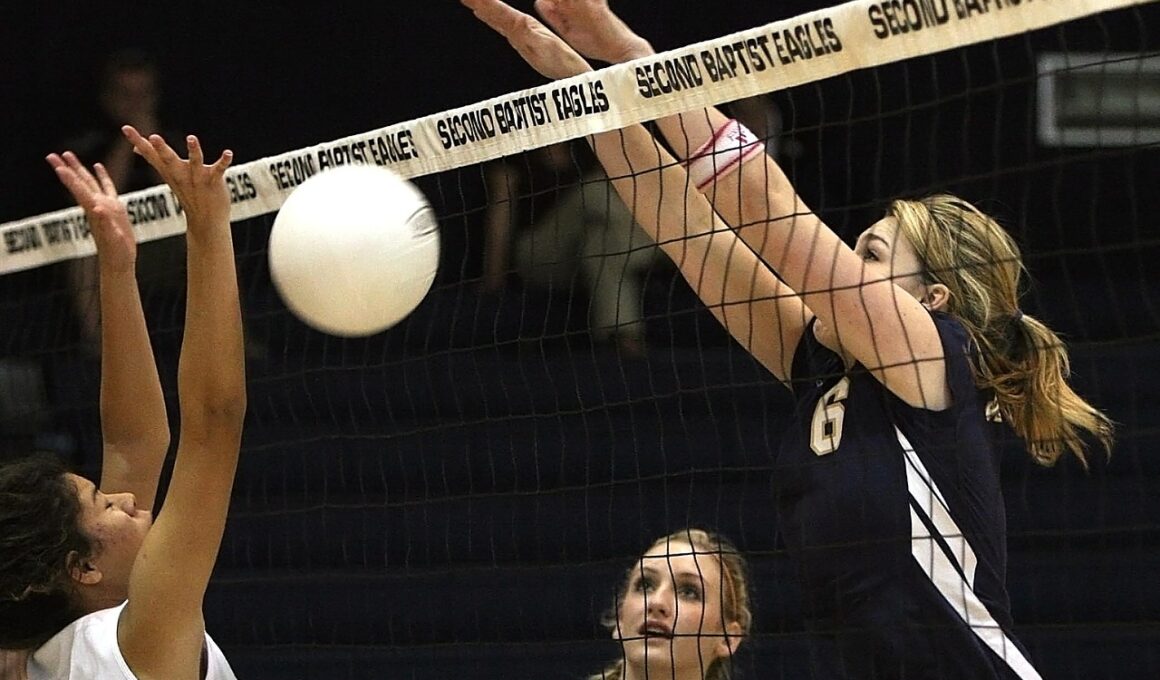Training to Anticipate Setters’ Decisions for Defense
Understanding the setter’s role in volleyball is crucial for defensive training. Setters decide where and how to distribute the ball to attackers during a game. To defend against these decisions effectively, players must anticipate the setter’s movements and actions. Training drills can be implemented to enhance players’ ability to read the setter’s body language and signals. One effective drill is the “setter recognition” drill, where players practice identifying various set formations. During this drill, players stay alert and respond to the setter’s cues in real-time. Watching video footage of professional matches also helps players analyze setting patterns and strategies. Trainers can emphasize different types of sets, such as quick sets or high sets, and stress how these influence defensive positioning. Defenders should focus on positioning and timing to react swiftly and block or dig the ball effectively. Communication is essential during this training, ensuring that all players are synchronized in their defense tactics. Additionally, incorporating competitive scenarios can further enhance readiness, as anticipating plays under pressure mimics real game situations. Ultimately, successful defense hinges on sharpening awareness and honing quick decision-making skills.
Developing an acute sense of awareness is critical for volleyball defenders. One effective strategy involves practicing how to read the setter’s body language. Body posture, eye direction, and hand signals can indicate the intended target for the upcoming set. Drills focused on these aspects can enhance anticipatory skills. For instance, players can engage in “mirror drills” where they must match their movements to the setter’s actions. This aids in recognizing subtle cues in real game situations. Additionally, defensive formations must be refined based on the tendencies observed. By tracking setter preferences over several matches, defenders can adapt their positioning accordingly. This can involve adjusting footwork to ensure that they are ready to intercept or block the ball. Awareness drills can include “scrimmage simulations,” where defenders practice against a variety of setter styles. It builds confidence and hones their ability to react promptly. Another useful technique is to create scenarios where defenders must choose between different defensive strategies. The more situations they encounter, the better prepared they will be for game time. Anticipation is a skill that evolves with experience and continuous practice.
Analyzing film footage is a powerful element in training to anticipate setters’ decisions. By reviewing past games, players can pinpoint setting tendencies and defensive gaps. Watching how different setters approach game scenarios provides insight into their decision-making processes. Players should take notes on common plays and how defenses respond. This analysis fosters a better understanding of strategic setups. Coaches can organize film sessions focused solely on the setter’s execution and their interactions with the hitters. Discussing these observations allows players to learn from both successes and mistakes. Another significant aspect is comparing various setters’ styles across different teams. This diversity helps players become versatile in their defensive strategies. Transitioning from practice to competition can be daunting, but applying lessons learned from analyzing footage can streamline this process. Timed assessments can help players implement these observations into live drills. Documenting changes in individual and team performance raises awareness of direct improvements in anticipation skills. Integrating technology, such as apps for tracking play sequences, can further enhance analysis. Continuous evaluation and refinement ensures that players remain adaptable and prepared for diverse setting styles.
Positioning and Timing
Positioning and timing are critical for effective volleyball defense. Defenders must coordinate their movements with the actions of the setter. One fundamental practice is to maintain a low, balanced stance, ready to move in any direction. This flexibility enables defenders to respond to sudden changes in play. Additionally, understanding the two primary types of sets—high ball sets and quick sets—allows defenders to adjust their anticipation timing. Players can implement drills focusing on these distinct set types. For instance, practice scenarios can involve a setter switching between both rapid and high arcs while defenders remain agile. Setters manipulate the ball’s trajectory and speed, and defenders must continuously refine their footwork to contend with these variations. Moreover, practicing against a live setter in-game-like settings tests timing and awareness skills. This can enhance the defender’s ability to read and react immediately. Moreover, tracking the hitter’s approach can provide additional clues. Anticipating how a hitter prepares to strike helps defenders position themselves accordingly. Timed repetitions during practice lock in these skills and improve overall responsiveness in game scenarios.
Communication among teammates is essential when training for defensive strategies. Clear discussion allows players to convey information about the setter’s cues easily. Establishing a strong communication system during drills proves invaluable in building defensive synergy. Using specific verbal signals and hand signs can streamline responses based on set variations. During practice sessions, performers can assign responsibilities and develop collective strategies to counter specific hitting tendencies. Implementing partner drills can enhance bonding and improve understanding amongst teammates. For instance, while practicing digging and blocking techniques, players can navigate responsibilities together, ensuring that one covers the high set while the other addresses the quick attacks. Communication extends beyond verbal interaction; it encompasses non-verbal cues as well. Reading teammates’ body language can signal readiness or adjustments in stance. Additionally, conducting strategy meetings can help solidify these concepts. Discussing successful and challenging plays enhances understanding of cooperative movements. Regular check-ins after drills allow players to reflect on their communication effectiveness. Ultimately, fostering an environment where players feel comfortable expressing concerns makes a significant difference in overall defensive strategies, ensuring cohesion during high-pressure situations.
Incorporating technology into training for volleyball defense offers distinct advantages. Utilizing performance analysis software enables teams to scrutinize behavior during play dynamically. Players can receive feedback based on their positioning and response times. This data-driven approach helps refine individual and team defensive strategies. Coaches can generate reports highlighting areas of improvement and adjustments necessary to optimize defense effectiveness. Another application involves using wearable devices to monitor movement efficiency in real-time. Such tools can gauge how well players maintain their form and agility. Continuous feedback loops encourage immediate adjustments during training. Additionally, virtual learning environments can provide gameplay simulations, assisting players in recognizing set patterns within different scenarios. These platforms expose athletes to various setter styles from around the league. Graphic representations can display trajectory paths, helping players visualize plays before they unfold. This leads to substantial improvements in anticipation abilities and reactions. Moreover, syncing video playback with real-time practice allows defenders to compare their performance against previous analysis. By embracing technology, players advance their comprehension and preparedness for the complexities of competitive volleyball, thus enhancing their defensive skills significantly.
Conclusion
In summary, training to anticipate setters’ decisions is a multifaceted process essential for effective volleyball defense. It encompasses awareness, positioning, timing, and communication, all crucial for successful execution. Enhancing these skills through diligent practice and analysis paves the way for more effective defense against various setter strategies. Defenders should consistently engage in drills that mitigate anticipating pitfalls. Reflecting upon previous games through film analysis reinforces the importance of adapting defensive responses. Integrating technology is another method that continues reshaping training methodologies. Wearable tools and performance analysis can greatly assist in honing defensive standards. Additionally, emphasizing cooperative communication fosters a strong team environment essential for success. By focusing on coordination among teammates, defenders can develop optimized strategies to respond accurately to setter actions, boosting overall efficiency on the court. Continuous practice and refinement of these strategies make players well-prepared for real-game scenarios. The combination of mental acuity and physical instinct is vital. Ultimately, mastering these defensive aspects leads to greater success in volleyball competitions and helps foster a winning team spirit.


